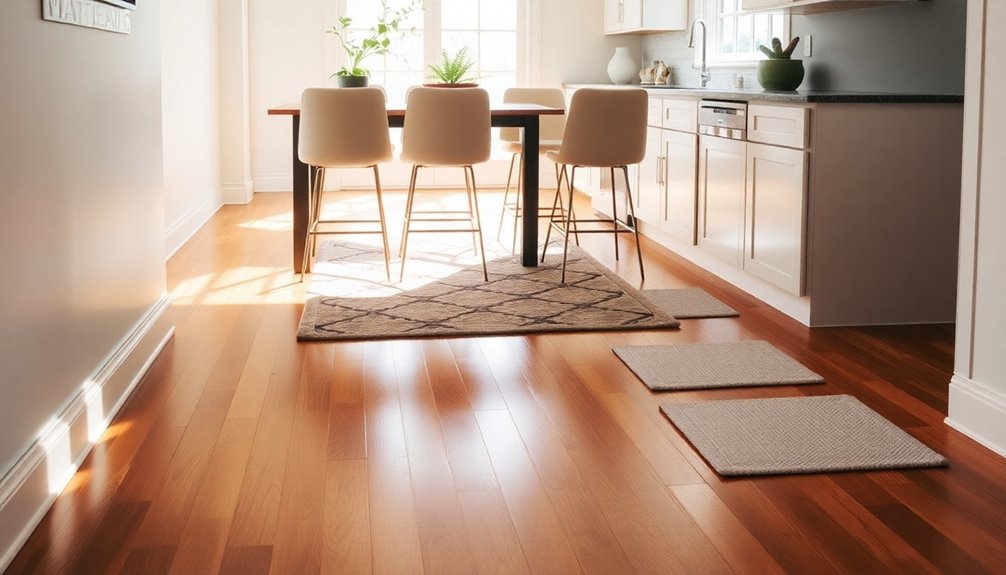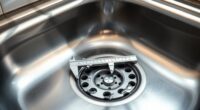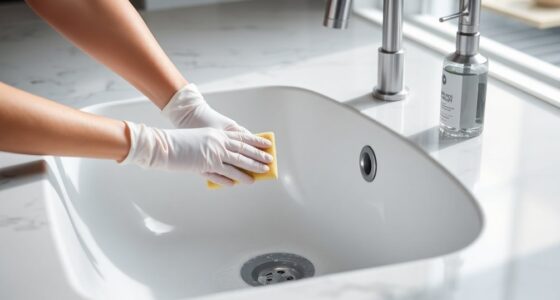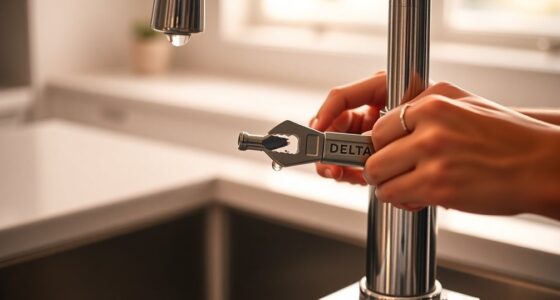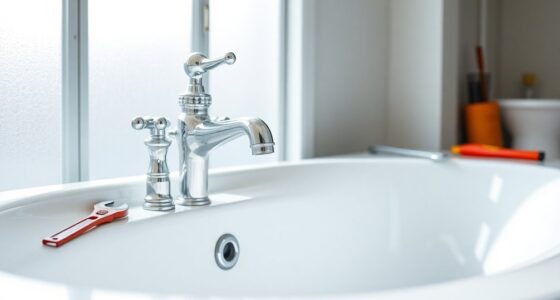To protect your hardwood floors in the kitchen, place rugs in high-risk areas like in front of the sink and under pet bowls. Use felt protectors on chair legs to avoid scratches. Sweep or vacuum often, especially around high-traffic spots. Always lift heavy items to prevent dragging. Wipe up spills right away and avoid wet mops. Keeping these tips in mind can help you maintain your floors, and there's more you can learn about effective protection strategies.
Key Takeaways
- Strategically place rugs in high-risk areas like the sink and under pet bowls to catch spills and moisture.
- Use sticky-back felt protectors on chair legs to prevent scratches and dents from furniture movement.
- Sweep or vacuum regularly, focusing on high-traffic spots, to keep dirt from accumulating on hardwood floors.
- Lift heavy items instead of dragging them to avoid scratching the floor surface during movement.
- Wipe up spills immediately and avoid wet mops to prevent moisture damage to hardwood floors.
Strategically Place Rugs
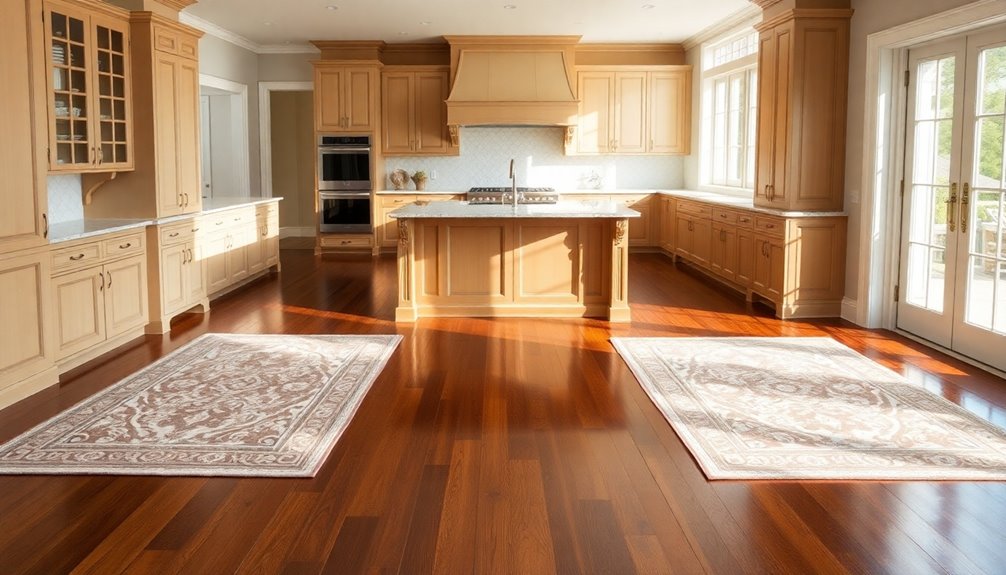
To protect your hardwood floors effectively, start by strategically placing rugs in key areas of your home.
Position rugs in high-risk spots like in front of the sink, dishwasher, and under pet bowls to trap spills and dirt before they reach your floors.
Choose rugs with 100% natural felt or rubber backing to prevent discoloration and moisture accumulation.
Larger rugs under the kitchen table can catch spills and crumbs, minimizing damage.
For durability and easy maintenance, opt for washable synthetic or absorbent cotton rugs, perfect for the kitchen's moisture-prone environment.
Regularly wash and shake out your rugs, ideally weekly, to maintain their cleanliness and effectiveness in protecting your hardwood floors from wear and tear.
Use Felt Protectors on Chairs
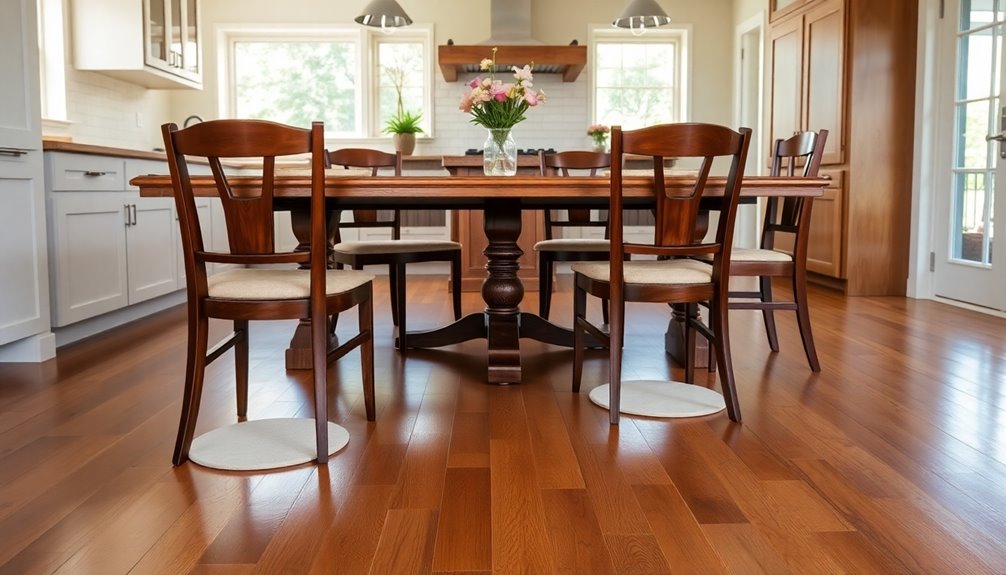
Using felt protectors on your chair legs is essential for keeping your hardwood floors scratch-free.
You should replace them every 3-6 months to maintain their effectiveness and prevent dirt buildup.
Importance of Felt Protectors
Felt protectors are crucial for preserving the beauty of your hardwood floors, especially when it comes to chairs that are frequently moved. Applying sticky-back felt rounds to chair legs can greatly reduce scratches and dents. They're a cost-effective way to maintain your flooring's aesthetic without constant refinishing.
| Benefits of Felt Protectors | Tips for Maintenance |
|---|---|
| Reduce scratches | Replace every 3-6 months |
| Prevent moisture damage | Check for secure attachment |
| Enhance floor longevity | Use non-abrasive materials |
Regularly checking the condition of your felt protectors is important. This guarantees they remain effective and continue to protect hardwood floors from wear caused by chair movement.
Replacement Frequency Guidelines
When it comes to protecting your hardwood floors, keeping an eye on the condition of your felt protectors is vital. To maintain their effectiveness, you should replace them every 3-6 months.
Over time, dirt can accumulate on the felt, reducing its ability to shield your hardwood kitchen floors from scratches and wear. Regularly inspect each protector to verify they're intact, as they can occasionally fall off.
Non-abrasive felt protectors are ideal; avoid rubber or plastic-backed options that can trap moisture and harm the wood.
Investing in quality felt protectors is a smart, cost-effective way to extend the lifespan of your floors and keep them looking beautiful.
Impact on Floor Integrity
To maintain the integrity of your hardwood floors, applying sticky-back felt rounds to each chair leg is essential. These simple protectors greatly reduce scratches and wear from frequent movement, keeping your floors looking pristine.
Here are three key benefits of using felt protectors:
- Minimizes Damage: Prevents scratches from chair legs when you pull them away from the table or sink.
- Cost-Effective: Protecting your hardwood now can save you from expensive repairs later.
- Easy Maintenance: Replace felt protectors every 3-6 months to keep them effective and avoid dirt accumulation.
Regularly check your felt protectors, as fallen or worn-out ones can lead to unprotected damage, compromising the integrity of your cherished hardwood floors.
Sweep or Vacuum Often
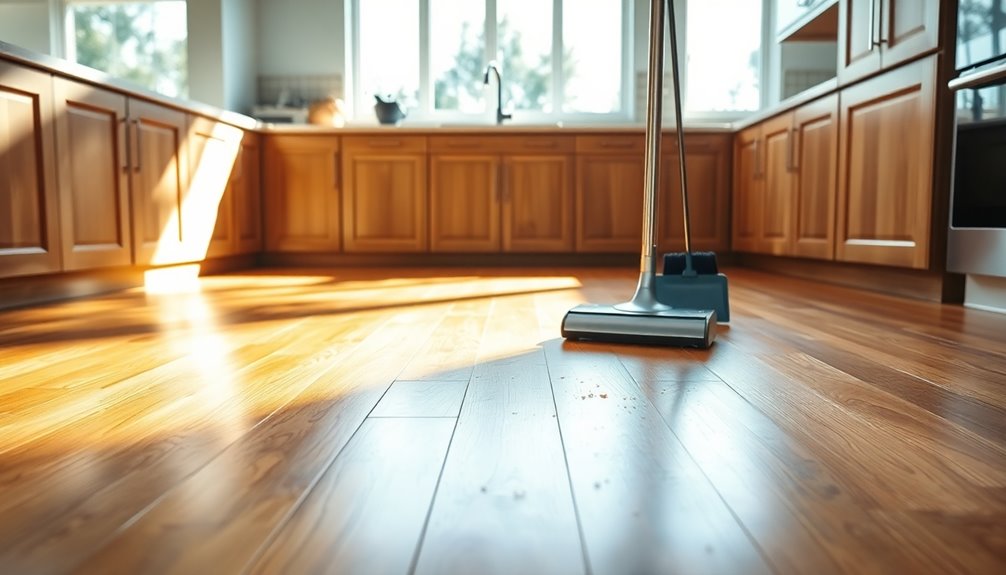
Regularly sweeping or vacuuming your hardwood floors is essential for keeping them in top shape.
Focus on high-risk areas in your kitchen, like under the dining table and in front of the kitchen sink, where dirt and crumbs tend to accumulate. By targeting these spots, you can effectively remove grit that can scratch and damage your floors.
It's not necessary to clean the entire floor daily; instead, regular attention to these problem areas will help prolong the life of your hardwood.
Consider keeping a dedicated vacuum in the kitchen to make this task more convenient.
Consistent sweeping or vacuuming will maintain your floors' appearance and prevent dirt buildup that could lead to more extensive damage over time.
Be Careful Moving Heavy Things
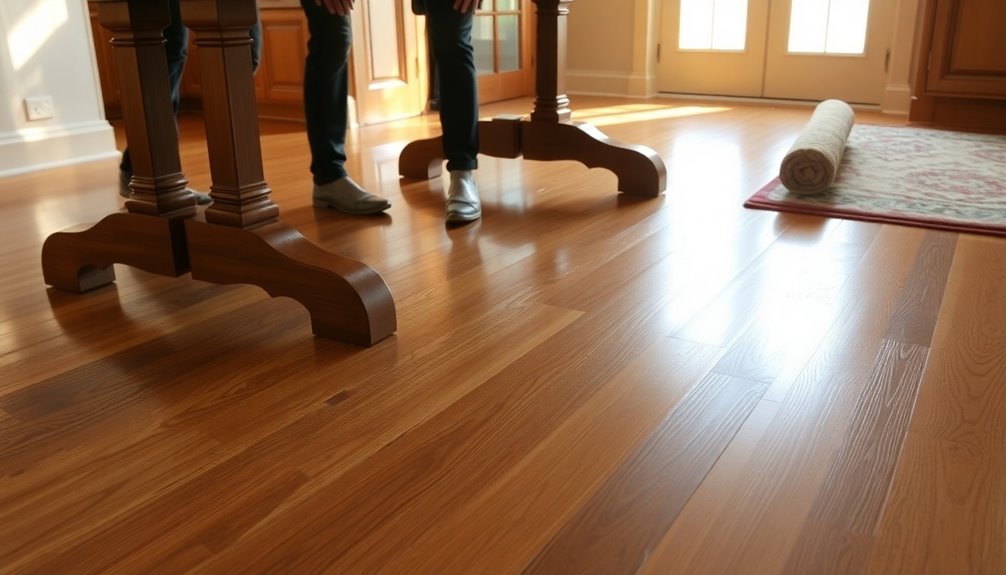
Keeping your hardwood floors clean isn't just about sweeping or vacuuming; it also involves being mindful when moving heavy items.
Here are some tips to protect the flooring in your kitchen:
- Lift, Don't Drag: Always lift heavy items instead of dragging them to prevent scratches.
- Use Plywood or Sliders: Place thin plywood underneath appliances or use furniture sliders to reduce friction and ease moving.
- Move Slowly: Take your time when shifting heavy objects to guarantee stability and control.
Watch Out for Moisture

How can you guarantee your hardwood floors stay pristine?
It's important to keep moisture at bay. Wipe up spills immediately to prevent moisture from seeping into the wood, which can cause cupping and warping over time.
Avoid using wet mops; instead, use a damp pad to clean your floors and minimize excess moisture exposure. Regularly check under sinks and around appliances for leaks. Early detection can save you from significant moisture-related damage.
Never use steam floor cleaners on hardwood, as the heat and moisture can lead to irreversible harm.
Prevention & Protection
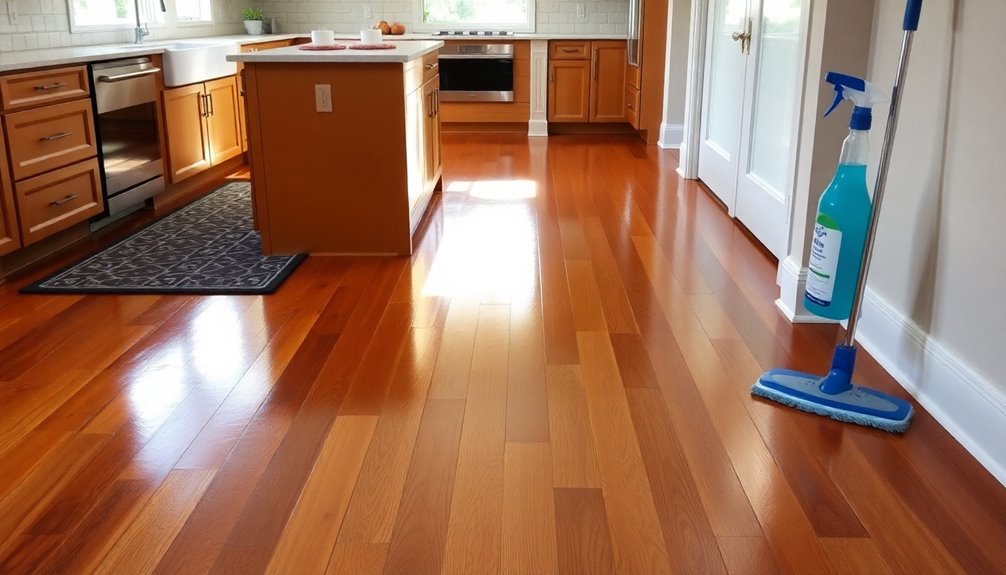
- Clean Up Spills Immediately: Prevent moisture damage by wiping up spills right away. Standing water can warp your floors or lead to mold growth.
- Use Nonslip Mats: Place mats in high-risk areas like in front of the sink and dishwasher. These mats protect your floors from spills and reduce slip hazards.
- Seal Your Floors: Apply a high-quality oil-based wood floor sealant after installation and periodically. This enhances protection against moisture and wear. Regular maintenance is crucial as it supports a healthier lifestyle by promoting cleanliness and hygiene.
Frequently Asked Questions
How Do You Protect Wooden Floors in the Kitchen?
To protect wooden floors, you'll want to start by placing rugs in high-traffic areas to absorb spills and prevent scratches.
Use felt protectors on furniture legs to minimize damage from movement.
Sweep or vacuum regularly to keep dirt and debris at bay.
Wipe up spills immediately, and avoid using too much water.
Finally, inspect the floor's finish and reapply protective coatings as needed to keep it looking great for years.
How Do You Maintain Hardwood Floors in the Kitchen?
To maintain your hardwood floors in the kitchen, you should regularly sweep or vacuum to keep dirt and crumbs at bay.
Clean up spills immediately with a damp cloth to prevent moisture damage.
Using rugs in high-traffic areas can help absorb spills and dirt.
Don't forget to apply felt protectors on furniture legs to avoid scratches.
Finally, reapply protective coatings as needed to keep your floors looking their best for years to come.
Is It OK to Have Hardwood Floors in a Kitchen?
Yes, it's okay to have hardwood floors in a kitchen, but you need to be careful. They can add warmth and beauty, enhancing your space.
Just remember, kitchens are prone to moisture and spills, so you must stay vigilant. Regular cleaning and maintenance are key.
Consider using area rugs in high-risk areas, and choose more moisture-resistant options to help protect your investment.
With proper care, hardwood floors can thrive in your kitchen.
How to Waterproof a Wood Floor in a Kitchen?
You'd think wood and water get along just fine, right?
To waterproof your wood floor, start by applying a high-quality oil-based sealant. Make sure the surface is clean and dry before you begin.
Use multiple thin layers, letting each dry for at least 24 hours. Keep an eye on it and reapply every few years, especially near moisture-prone spots.
If you're still worried, consider waterproof engineered hardwood for added peace of mind.
Conclusion
By following these simple tips, you can keep your hardwood floors in the kitchen looking beautiful for years to come. Did you know that hardwood floors can last up to 100 years with proper care? That's a long time, so it's worth the effort! Whether it's placing rugs strategically or being mindful of moisture, every little action helps. So, take these steps to protect your investment and enjoy the timeless elegance of your kitchen flooring.
